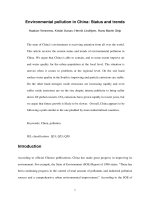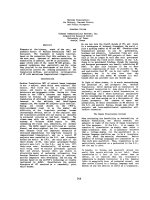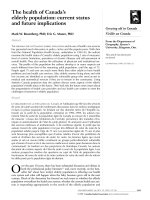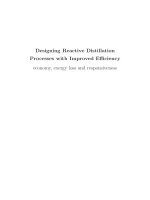reactive distillation status and future directions kai sundmacher
Bạn đang xem bản rút gọn của tài liệu. Xem và tải ngay bản đầy đủ của tài liệu tại đây (4.91 MB, 300 trang )
Kai Sundmacher and Achim Kienle
(Eds.)
Reactive Distillation
Status and Future Directions
Reactive Distillation. Edited by Kai Sundmacher, Achim Kienle
Copyright c 2002 Wiley-VCH Verlag GmbH & Co. KGaA
ISBNs: 3-527-30579-3 (Hardback); 3-527-60052-3 (Electronic)
Also of Interest
W. Ehrfeld, V. Hessel, H. LoÈwe
Microreactors ± New Technology
for Modern Chemistry (2000)
ISBN 3-527-29590-9
S. P. Nunes and K V. Peinemann (Eds.)
Membrane Technology in the Chemical Industry (2001)
SBN 3-527-28485-0
J. G. Sanchez Marcano and Th. T. Tsotsis
Catalytic Membranes and Membrane Reactors (2002)
ISBN 3-527-30277-8
H. Schmidt-Traub (Ed.)
Preparative Chromatography
of Fine Chemicals and Pharmaceutical Agents (planned 2003)
ISBN 3-527-30643-9
Reactive Distillation. Edited by Kai Sundmacher, Achim Kienle
Copyright c 2002 Wiley-VCH Verlag GmbH & Co. KGaA
ISBNs: 3-527-30579-3 (Hardback); 3-527-60052-3 (Electronic)
Kai Sundmacher and Achim Kienle (Eds.)
Reactive Distillation
Status and Future Directions
Reactive Distillation. Edited by Kai Sundmacher, Achim Kienle
Copyright c 2002 Wiley-VCH Verlag GmbH & Co. KGaA
ISBNs: 3-527-30579-3 (Hardback); 3-527-60052-3 (Electronic)
Prof. Dr Ing. Kai Sundmacher,
Prof. Dr Ing. Achim Kienle
MaxPlanck Institute for Dynamics
of Complex Technical Systems
Sandtorstraûe 1
39106 Magdeburg
Germany
This book was carefully produced. Nevertheless,
editors, authors and publisher do not warrant the
information contained therein to be free of errors.
Readers are advised to keep in mind that statements,
data, illustrations, procedural details or other items
may inadvertently be inaccurate.
Library of Congress Card No.: applied for
A catalogue record for this book is available from the
British Library.
Bibliographic information puplished by Deutsche
Bibliothek
Die Deutsche Bibliothek lists this publication in the
Deutsche Nationalbibliografie; detailed bibliographic
data is available in the Internet a
http://dnb. ddb.de.
c 2003, WILEY-VCH Verlag GmbH & Co. KGaA,
Weinheim
All rights reserved (including those of translation in
other languages). No part of this book may be
reproduced in any form ± by photoprinting, micro-
film, or any other means ± nor transmitted or trans-
lated into machine language without written
permission from the publishers. Registered names,
trademarks, etc. used in this book, even when not
specifically marked as such, are not to be considered
unprotected by law.
Printed in the Federal Republic of Germany.
Printed on acid-free paper.
Typesetting Hagedorn Kommunikation, Viernheim
Printing Strauss Offsetdruck GmbH, MoÈrlenbach
Bookbinding Litges & Dopf Buchbinderei GmbH,
Heppenheim
ISBN 3-527-30579-3
Reactive Distillation. Edited by Kai Sundmacher, Achim Kienle
Copyright c 2002 Wiley-VCH Verlag GmbH & Co. KGaA
ISBNs: 3-527-30579-3 (Hardback); 3-527-60052-3 (Electronic)
Contents
Preface XI
List of Contributors XIX
Part I Industrial Applications
1 Industrial Applications of Reactive Distillation
3
1.1 Introduction 3
1.2 Etherification: MTBE, ETBE, and TAME 14
1.3 Dimerization, Oligomerization, and Condensation 15
1.4 Esterification: Methyl Acetate and Other Esters 16
1.5 Hydrolysis of Esters 18
1.6 Hydration 20
1.7 Hydrogenation/Hydrodesulfurization/Hydrocracking 20
1.7.1 Benzene to Cyclohexane 21
1.7.2 Selective Hydrogenation of C
4
Stream 21
1.7.3 Hydrogenation of Pentadiene 21
1.7.4 C
4
Acetylene Conversion 22
1.7.5 Hydrodesulfurization, Hydrodenitrogenation, and Hydrocracking 22
1.7.6 Miscellaneous Hydrogenations 22
1.8 Chlorination 23
1.9 Acetalization/Ketalization 23
1.10 Recovery and Purification of Chemicals 24
1.11 Difficult Separations 25
1.12 Chemical Heat Pumps 26
1.13 RD with Supercritical Fluids 26
1.14 Conclusions 26
2 Reactive Distillation Process Development
in the Chemical Process Industries
30
2.1 Introduction 30
2.2 Process Synthesis 32
2.3 Process Design and Optimization 35
VContents
Reactive Distillation. Edited by Kai Sundmacher, Achim Kienle
Copyright c 2002 Wiley-VCH Verlag GmbH & Co. KGaA
ISBNs: 3-527-30579-3 (Hardback); 3-527-60052-3 (Electronic)
2.4 Limitations of the Methods for Synthesis and Design:
the Scale-Up Problem
37
2.5 Choice of Equipment 38
2.6 Some Remarks on the Role of Catalysis 46
2.7 Conclusions 46
2.8 Acknowledgments 47
2.9 Notation 47
3 Application of Reactive Distillation and Strategies in Process Design 49
3.1 Introduction 49
3.2 Challenges in Process Design for Reactive Distillation 51
3.2.1 Feasibility Analysis 51
3.2.2 Catalyst and Hardware Selection 51
3.2.3 Column Scale-Up 51
3.3 MTBE Decomposition via Reactive Distillation 52
3.3.1 Conceptual Design 52
3.3.2 Model Development 54
3.3.2.1 Catalyst Selection and Reaction Kinetics 55
3.3.2.2 Phase Equilibrium Model 55
3.3.2.3 Steady-State Simulation 56
3.3.3 Lab-Scale Experiments 57
3.3.4 Pilot-Plant Experiments 58
3.4 Conclusions 61
Part II Physicochemical Fundamentals
4 Thermodynamics of Reactive Separations
65
4.1 Introduction 65
4.2 Process Models for Reactive Distillation 66
4.2.1 Outline 66
4.2.2 Case Study: Methyl Acetate 66
4.3 Equilibrium Thermodynamics of Reacting Multiphase Mixtures 70
4.4 Fluid Property Models for Reactive Distillation 74
4.4.1 Outline 74
4.4.2 Examples 75
4.4.2.1 Hexyl Acetate: Sensitivity Analysis 75
4.4.2.2 Methyl Acetate: Prediction of Polynary Vapor±Liquid Equilibria 77
4.4.2.3 Butyl Acetate: Thermodynamic Consistency 81
4.4.2.4 Ethyl Acetate: Consequences of Inconsistency 82
4.4.2.5 Formaldehyde Water Methanol:
Intrinsically Reactive Complex Mixture
83
4.5 Experimental Studies of Phase Equilibria in Reacting Systems 88
4.5.1 Outline 88
4.5.2 Reactive Vapor±Liquid Equilibria 90
4.5.2.1 Batch Experiments 90
4.5.2.2 Flow Experiments 91
VI Contents
4.5.2.3 Recirculation Experiments 92
4.6 Conclusions 92
4.7 Acknowledgments 93
4.8 Notation 93
5 Importance of Reaction Kinetics for Catalytic Distillation Processes 97
5.1 Introduction 97
5.2 Reactive Ideal Binary Mixtures 98
5.2.1 Reaction-Distillation Process with External Recycling 100
5.2.1.1 (T,T)-Analysis 101
5.2.1.2 (T, N
min
)-Analysis 102
5.2.2 Distillation Column with Reactive Reboiler 103
5.2.3 Fully Reactive Distillation Column 106
5.3 Kinetic Effects on Attainable Products 109
5.3.1 Singular Point Analysis 110
5.3.2 Ideal Ternary Mixtures 112
5.3.2.1 Case a: a
AC
0.2, a
BC
3.0 112
5.3.2.2 Case b: a
AC
5.0, a
BC
3.0 112
5.3.3 Non-Ideal Mixtures 115
5.3.3.1 Synthesis of MTBE 115
5.3.3.2 Synthesis of TAME 117
5.3.4 Systems with Liquid-Phase Splitting 121
5.3.5 Systems with Interfacial Mass-Transfer Resistances 126
5.4 Determination and Analysis of Reaction Kinetics 129
5.4.1 Physicochemical Transport Phenomena 129
5.4.2 Process Evaluation by Dimensionless Numbers 131
5.4.3 Formulation of Reaction Rate Expressions 133
5.4.4 Importance of Transport Resistances for Column Operation 135
5.5 Conclusions 138
5.6 Acknowledgments 139
5.7 Notation 140
Part III Process Design
6Feasibility and Process Alternatives for Reactive Distillation
145
6.1 Introduction 145
6.2 Motivation 147
6.3 Flash Cascade Model 153
6.4 Feasibility Hypothesis 156
6.5 Bifurcation Analysis of the Flash Cascade Model 160
6.6 Conclusions 165
6.7 Notation 165
VIIContents
7 Hardware Selection and Design Aspects
for Reactive Distillation Columns
169
7.1 Introduction 169
7.2 Hardware for Homogeneous Reactive Distillation 169
7.2.1 Case Study for Methyl Acetate Production 173
7.3 Hardware for Heterogeneous Reactive Distillation 177
7.3.1 Different Hardware Configurations 177
7.3.2 Hardware Selection Aspects 183
7.4 The Side-Reactor Concept 185
7.5 Conclusions 187
7.6 Acknowledgments 188
8 Development of Unstructured Catalytic Packing
for Reactive Distillation Processes
190
8.1 Introduction 190
8.2 Requirements for RD Catalytic Packing 190
8.3 State of the Art: Catalytic Packing for RD Processes 191
8.3.1 Commercial Packing 191
8.3.2 Alternative Concepts 193
8.3.2.1 Catalysts Made of Pure Catalytic Material 193
8.3.2.2 Catalysts Supported on Carrier Materials 194
8.4 New Catalyst Concept: Porous Polymer/Carrier Composite 195
8.4.1 Requirements for the Carrier Materials 198
8.4.2 Requirements for the Polymerization Process 199
8.5 Preparation of Sulfonated Ion-Exchange Polymer/Carrier Catalysts 200
8.6 Performance of Polymer/Carrier Catalysts 203
8.6.1 Influence of Polymer Content and Reactant Concentration 204
8.6.2 Influence of Reaction Temperature 205
8.6.3 Influence of Cross-Linking 207
8.6.4 Influence of Cross-Linking at Low Polymer Content 207
8.6.5 Influence of Cross-Linking at High Polymer Content 209
8.7 Outlook: Extension to Other Synthetic Processes
With Integrated Separation
210
8.7.1 Reactive Stripping 210
8.7.2 Reactive Chromatography 211
8.7.3 Polymer-Assisted Solution-Phase Organic Synthesis 212
8.8 Conclusions 212
Part IV Modeling and Process Control
9 Modeling of Homogeneous and Heterogeneous
Reactive Distillation Processes
217
9.1 Introduction 217
9.2 Equilibrium Stage Models 217
9.3 Non-equilibrium Stage Modeling 220
9.3.1 The Conventional NEQ Model 220
VIII Contents
9.3.2 NEQ Modeling of Reactive Distillation 223
9.3.3 Homogeneous Systems 223
9.3.4 Heterogeneous Systems 225
9.3.5 NEQ Cell Model 227
9.3.6 Properties, Hydrodynamics, and Mass Transfer 232
9.4 Comparison of EQ and NEQ Models 232
9.5 AView of Reactive Distillation Process Design 237
9.6 Notation 238
10 Nonlinear Dynamics and Control of Reactive Distillation Processes 241
10.1 Introduction 241
10.2 Multiplicity and Oscillations in Chemical Process Systems 242
10.3 Methyl Formate Synthesis 245
10.3.1 Singularity Analysis of a One-Stage Column 246
10.3.2 T/T-Analysis of Lab-Scale Column 247
10.3.3 Continuation Analysis of Lab-Scale Column 248
10.4 Ethylene Glycol Synthesis 249
10.4.1 Singularity Analysis of a One-Stage Column 250
10.4.2 Continuation Analysis of Industrial Size Distillation Column 251
10.5 MTBE and TAME Synthesis 257
10.5.1 MTBE Synthesis 257
10.5.2 TAME Synthesis 258
10.5.3 Kinetic Instabilities for Finite Transport Inside the Catalyst 260
10.5.4 Oscillatory Behavior 261
10.6 Classification 262
10.7 Nonlinear Wave Propagation 264
10.8 Control 271
10.8.1 Control Structure Selection 271
10.8.2 Control Algorithms 274
10.9 Conclusions 276
10.10 Acknowledgments 278
Index 283
IXContents
Preface
In the chemical process industries, chemical reaction and the purification of the
desired products by distillation are usually carried out sequentially. In many
cases, the performance of this classic chemical process structure can be signifi-
cantly improved by integration of reaction and distillation in a single multifunc-
tional process unit. This integration concept is called `reactive distillation' (RD);
when heterogeneous catalysts are applied the term `catalytic distillation' is often
used.
As advantages of this integration, chemical equilibrium limitations can be
overcome, higher selectivities can be achieved, the heat of reaction can be
used in situ for distillation, auxiliary solvents can be avoided, and azeotropic
or closely boiling mixtures can be more easily separated than in non-RD.
Increased process efficiency and reduction of investment and operational
costs are the direct results of this approach. Some of these advantages are realized
by using reaction to improve separation; others are realized by using separation to
improve reaction.
Most important industrial applications of RD are in the field of esterification pro-
cesses such as the famous Eastman Chemical Co.'s process for the synthesis of
methyl acetate [1]. This process combines reactive and non-reactive sections in a
single hybrid RD column and thereby replaces a complex conventional flowsheet
with 11 process units. With this RD technology investment and energy costs
were reduced by factor five [2]. Another success story of RD was started in the
1980s by using this technology for the preparation of the ethers MTBE, TAME,
and ETBE, which are produced in large amounts as fuel components because of
their excellent antiknock properties [3].
Nowadays, many research and development activities are under way to introduce
RD into other chemical processes. But despite the convincing success of RD in
esterification and etherification applications, it is important to note that RD is
not always advantageous. In some cases it is not even feasible. Therefore, the
development of reliable tools for the conceptual design of RD processes is one
of the most important fields of current research activities.
Due to the interaction of reaction and distillation in one single apparatus, the
steady-state and dynamic operational behavior of RD can be very complex. There-
fore, suitable process control strategies have to be developed and applied, ensuring
XIPreface
Reactive Distillation. Edited by Kai Sundmacher, Achim Kienle
Copyright c 2002 Wiley-VCH Verlag GmbH & Co. KGaA
ISBNs: 3-527-30579-3 (Hardback); 3-527-60052-3 (Electronic)
optimal and safe operation. This is another very important area of current and
future research and development.
Today, RD is discussed as one part of the broader area of reactive separation,
which comprises any combination of chemical reaction with separation such as
distillation, stripping, absorption, extraction, adsorption, crystallization, and mem-
brane separation. In the next decade, unifying approaches to reactive separators
should be developed allowing the rigorous selection of the most suitable type of
separation to be integrated into a chemical reactor.
Despite the fact that the basic idea of combining reaction and distillation is old,
there has been an enormously growing interest in the design and operation of RD
processes in recent years. Fig. 1 shows the number of journal papers that have
appeared on the subject during the last 30 years. It is worth noting that the total
number of publications including the papers in conference proceedings and so
on is a multiple of the number of publications in scientific journals. In an analo-
gous manner, the industrial interest in applying this attractive process technology
has increased continuously. This is reflected by the steadily growing number of
patents applied since 1970.
Despite the large number of publications only a few review papers have been
written on this topic so far. Podrebarac et al. [4] highlighted the advantages of
RD and gave an overview on potential uses of catalytic distillation. The review by
Taylor and Krishna [5] focused mainly on the modeling aspects of RD. Doherty
and Malone [6] gave valuable commentaries on future trends and challenges in
this field of research. Gorak and co-workers [7] summarized rate-based modeling
techniques for RD and also for reactive absorption. Book chapters on RD are
available in volumes on distillation technology by Stichlmair and Fair [8], and by
Doherty and Malone [9], and also in a recent book on reactive separations [10].
XII Preface
1970
1975 1980 1985 1990 1995 2000
0
20
40
60
80
100
Year
Number of Patents & Journal Publications
papers
patents
Fig. 1. Journal publications on reactive and catalytic distillation over the last three decades
according to the Science Citation Index and patents in these fields according to the Deutsches
Patent- und Markenamt (www.depatis.net)
Moreover, since RD is going to become a more established technology, it has
found its way into classic chemical engineering encyclopedias [11, 12].
However, a comprehensive volume covering all aspects of application, design,
analysis, and control of RD processes is still missing. To fill this gap, the present
book was prepared. Its chapters are written by leading international experts from
both academic institutions and industrial companies. They summarize the present
state of knowledge and give an outlook on challenging issues in the future.
The book is divided into four parts: Part I surveys various industrial applications
and covers both established large-scale processes as well as new chemical reaction
schemes with high future potential. Part II provides the vital details for analysis of
reactive phase equilibria, and discusses the importance of chemical reaction
kinetics, while Part III focuses on identifying feasible column configurations
and the design of their internal structure. Analysis and control of the complex
dynamic and steady-state behavior of RD processes are described in Part IV.
Part I Industrial Applications
Chapters 1±3 give a survey of chemical reaction schemes that are performed
successfully in RD columns and present ideas for new applications. Sharma and
Mahajani (Chapter 1) point out that RD has acquired its new status only recently
in spite of the fact that the concept has been used in various processes since 1860s.
Over the last two decades, especially after the commissioning of large-scale plants
for MTBE and methyl acetate production, RD has been seen as a promising reac-
tor/separator that can fulfill multiple objectives simultaneously. With respect to
applications, engineers and chemists have started looking beyond the classic
esterification and etherification reactions. Hydrogenation, hydrodesulfurization,
isomerization, and oligomerization are some of the unconventional examples to
which RD has been successfully applied on a commercial scale. Moreover, hydro-
lysis, alkylation, acetalization, hydration, and transesterification have also been
identified as potential candidates for RD. Another important area of application
is the removal of small amounts of impurities to obtain high quality product
(e. g., phenol). RD can also be used for the recovery of valuable products like acetic
acid, glycols, lactic acid, and so on from waste streams.
Schoenmakers and Bessling (Chapter 2) give an overview of the tools that are
available today and the methods that are now introduced in the industrial practice
of chemical companies. A process synthesis procedure gives good qualitative
reference points. Simulation tools have been developed that are mainly based on
equilibrium models. But there are further steps to go on the way to the realization
of an industrial plant. The scale-up from the miniplant scale used for the experi-
mental validation of a new process is well known for conventional distillation,
but complicated by several facts for RD especially in the case of heterogeneous
catalysis. To overcome these problems either reference plant experience on an
industrial scale or (if not available) further research is required. Other options
both for homogeneous and heterogeneous catalysis are possible and are discussed
XIIIPreface
in the contribution. The authors emphasize that the combination of reaction and
distillation not necessarily has to be operated in a counter-current column. For
slower reactions a broad variety of equipment not necessarily containing columns
can be used.
In Chapter 3, Tuchlenski and colleagues illustrate a procedure for process design
on an industrial scale using the decomposition of the fuel ether MTBE into metha-
nol and isobutene as an important example. Based solely on thermodynamic con-
siderations, a plausible column configuration is derived. In order to study the scale-
up of structured packing, experiments were performed on the lab scale as well as
on the pilot scale. While lab scale experiments could be described satisfactorily
with a simple equilibrium stage model, the same approach failed in the case of
pilot plant experiments. Hydrodynamics, maldistribution and/or mass-transfer
limitations might be a reasonable explanation and are worth more thorough inves-
tigation. The authors conclude that pilot plant operation is indispensable to estab-
lish a heterogeneously catalyzed RD process.
Part II Physicochemical Fundamentals
Chapters 4 and 5 are dedicated to the thermodynamic and kinetic fundamentals of
RD processes. In Chapter 4, Hasse reviews the fundamentals of thermodynamic
modeling of simultaneous phase and reaction equilibria. The author emphasizes
the importance of consistency of phase equilibrium models. Thermodynamic con-
sistency provides a sound basis for developing predictive reaction models for RDs,
which are valid over a wide range of concentrations. To develop phase equilibrium
models, reliable experimental data of phase equilibria in reactive systems have to
be available. For successful measurements, suitable experimental techniques are
needed, which are briefly summarized in this chapter. Criteria for their selection
are also given.
Sundmacher and Qi (Chapter 5) discuss the role of chemical reaction kinetics on
steady-state process behavior. First, they illustrate the importance of reaction ki-
netics for RD design considering ideal binary reactive mixtures. Then the feasible
products of kinetically controlled catalytic distillation processes are analyzed based
on residue curve maps. Ideal ternary as well as non-ideal systems are investigated
including recent results on reaction systems that exhibit liquid-phase splitting. Re-
cent results on the role of interfacial mass-transfer resistances on the attainable top
and bottom products of RD processes are discussed. The third section of this con-
tribution is dedicated to the determination and analysis of chemical reaction rates
obtained with heterogeneous catalysts used in RD processes. The use of activity-
based rate expressions is recommended for adequate and consistent description
of reaction microkinetics. Since particles on the millimeter scale are used as cata-
lysts, internal mass-transport resistances can play an important role in catalytic dis-
tillation processes. This is illustrated using the syntheses of the fuel ethers MTBE,
TAME, and ETBE as important industrial examples.
XIV Preface
Part III Process Design
Chapters 6±8 focus on process design, i. e. determining suitable column configura-
tions, suitable operating conditions, and suitable column internals. Chapter 6 by
Doherty and co-workers is concerned with conceptual process design. Geometrical
methods are provided, which allow at the initial stages of process development to
decide quickly whether RD is likely to be a good process concept. The attainable
region approach for reaction-mixing systems is applied to systems with simulta-
neous reaction and separation in order to assess the possible selectivity-yield-con-
version benefits of this technology. Feasible direct and indirect sharp splits are pre-
dicted with a model in which each column section is represented by a series of co-
current isobaric flashes. In the limits of no reaction, or of chemical equilibrium,
the model reduces to conventional models for distillation lines, and each column
section can be represented by the same equations. However, at intermediate rates
of reaction the models for the column sections are different, and new results are
obtained. A bifurcation study shows the limits of feasibility including the influence
of flow rate, catalyst level and holdup. Unlike distillation without reaction, limited
ranges of feasibility in all of these variables are found.
Chapter 7 by Krishna is concerned with hardware selection and design for RD
columns. An overview on available hardware for homogeneously as well as hetero-
geneously catalyzed RD processes is given. Criteria for suitable hardware selection
are discussed and illustrated by different case studies. It is shown that the require-
ments for hardware selection are different from conventional non-RD. The author
concludes that especially for heterogeneously catalyzed RD processes it is almost
impossible to reconcile the conflicting requirements and introduces the side reac-
tor concept as a promising alternative to overcome many of these conflicting hard-
ware issues.
Chapter 8 by Kunz and Hoffmann introduces a special catalyst technology devel-
oped by the authors. State of the art in industrial catalyst technology is to use cat-
alyst particles with a size in the millimeter range and to sew these particles into a
wire mesh or glass-fiber clothing to form structured packing. The manufacturing
process makes this type of packing expensive. In contrast to this, unstructured
packing materials like Raschig rings are much cheaper. However, so far, Raschig
rings with comparable catalytic activity are not commercially available. In the pres-
ent contribution the authors introduce various methods for the preparation of cat-
alytically active rings by polymerization of ion-exchange resin into the pores of a
carrier material. Application is tested for MTBE synthesis. Based on this technol-
ogy monolithic polymer/carrier materials were developed, which can be used for
other reactive separation processes like reactive chromatography and polymer-
assisted solution-phase organic synthesis.
XVPreface
Part IV Modeling and Process Control
Chapters 9 and 10 are on modeling, dynamics, and control of RD processes. The
contribution by Taylor and Krishna (Chapter 9) deals with the modeling of homo-
geneously and heterogeneously catalyzed RD processes. The focus of this contribu-
tion is on steady-state behavior. First, the equilibrium stage model is introduced,
which is readily obtained from the non-reactive case by adding reaction terms.
Afterwards, non-equilibrium stage models are introduced as a more rigorous
approach. It is shown that different types of non-equilibrium models apply to
homogeneously and heterogeneously catalyzed processes. In the homogeneous
case, further distinction has to be made between slow and fast liquid-phase reac-
tions. In the heterogeneous case distinction between negligible and finite intrapar-
ticle diffusion inside the catalyst is essential. Finite intraparticle diffusion can be
modeled with the dusty fluid model, which is an extension by the authors of the
well-known dusty gas model. Finally, cell models are introduced to account for
non-ideal flow patterns on distillation trays and maldistribution in packed col-
umns. Equilibrium and non-equilibrium models are compared for different pro-
cess applications including MTBE, TAME, and ethylene glycol synthesis and a per-
spective on the use of non-equilibrium models in RD process design is given.
The final contribution by Kienle and Marquardt (Chapter 10) gives an overview
of the present knowledge of non-linear dynamics and control of RD columns. First,
focus is on open-loop dynamics. It is shown that RD processes can sometimes
show an intricate non-linear dynamic behavior, a profound understanding of
which is not only of scientific interest but also very important for improved process
design and operation. Basic terminology, methods, and tools are introduced for
analyzing and understanding non-linear dynamics. Three different types of reac-
tion systems are introduced including esterification, etherification, and the ethy-
lene glycol system. Different patterns of behavior are identified depending on
the reaction systems and the operating conditions. In the equilibrium regime of
the chemical reaction the dynamic behavior of a RD column is qualitatively similar
to a non-RD column, whereas in the kinetic regime the chemical reaction rate is
dominating. For closely boiling mixtures, like in many etherification processes,
the behavior in the kinetic regime is very similar to a single phase isothermal re-
actor. Additional effects arise for mixtures of components with completely different
boiling points as for the ethylene glycol system, for example. In the second part,
available guidelines for control structure selection and control system design are
summarized. Emphasis is on the equilibrium regime. Here, similar methods as
in non-RD apply. Additional complexity is introduced in inferential control
schemes, where temperature is used as a cheap, fast, and reliable measurement
instead of concentration. The authors conclude that control studies for kinetically
controlled processes are missing to a large extent.
XVI Preface
Book History and Acknowledgments
The present book is the outcome of the 1st International Workshop on Reactive Dis-
tillation held at the Max Planck Institute for Dynamics of Complex Technical Sys-
tems in Magdeburg, Germany, on 2±3 July 2001. The goal of this workshop was to
bring together world-renowned pioneering scientists and leading industrial experts
in the field of RD on a common platform. The workshop was organized by the edi-
tors and their colleagues with financial support from the Kompetenznetz Verfah-
renstechnik Pro3 e. V., Germany, which is gratefully acknowledged.
The editors would like to thank their colleagues Nancy Eckstein, Erik Stein, and
Frank Steyer for their support in organizing the Max Planck workshop. We are also
very grateful to Erik Stein, Martin HaÈfele, Henning Schramm, and Zhiwen Qi for
their support in collecting the manuscripts and in standardizing formats. Last but
not least, we are very thankful to Karin Sora of Wiley-VCH for her helpful assis-
tance during the preparation of the book.
Max-Planck-Institut fuÈr Dynamik Kai Sundmacher
komplexer technischer Systeme and Achim Kienle
Magdeburg, Germany
April 2002
XVIIReferences
References
1 V. H. Agreda, L. R. Partin, W. H. Heise,
Chem. Eng. Progr. 1990, 86,40±46.
2 J. J. Siirola, AIChE Symp. Ser. 1995, 91,
222±233.
3 L. A. Smith, Method for the Preparation
of Methyl Tertiary Butyl Ether,USPatent
No. 4.978.807, 1990.
4 G. G. Podrebarac, F. T. Ng, G. L.
Rempel, Chemtech 1997, May, 37± 45.
5 R. Taylor and R. Krishna, Chem. Eng.
Sci. 2000, 55, 5183±5229.
6 M. F. Doherty, M. F. Malone, Ind. Eng.
Chem. Res. 2000, 39, 3953±3957.
7 C. Noeres, E. Y. Kenig, A. Gorak, Chem.
Eng. Proc. 2002,inpress.
8 J. G. Stichlmair, J. R. Fair, Distillation:
Principles and Practices,Wiley-VCH,
New York, 1998, 252±283.
9 M. F. Doherty, M. F. Malone, Concep-
tual Design of Distillation Systems,
McGraw-Hill, New York, 2001,
427±505.
10 G. P. Towler, S. T. Frey, in Reactive
Separation Processes (Ed. S. Kulprathi-
panja), Taylor & Francis, New York,
2002.
11 M. Sakuth, D. Reusch, R. Janowsky, in
Ullmann's Encyclopedia of Industrial
Chemistry (Eds. B. Elvers, S. Hawkins,
G. Schulz ), 6th edn, Wiley-VCH,
Weinheim, 1999.
12 M. Doherty, in Chemical Engineers
Handbook (Eds: Perry, Green), Vol 13,
McGraw Hill, New York, 1998,81±85.
List of Contributors
XIXList of Contributors
B. Bessling
BASF Corporation
Wyandotte, MI, USA
N. Chadda
Department of Chemical Engineering
University of Massachusetts
Amherst, MA 01003-3110, USA
M. F. Doherty
Department of Chemical Engineering
University of California
Santa Barbara, CA 93106, USA
T. Frey
Lehrstuhl fuÈr Fluidverfahrenstechnik
Technische UniversitaÈt MuÈnchen
85747 Garching, Germany
S. B. Gadewar
Department of Chemical Engineering
University of Massachusetts
Amherst, MA 01003-3110, USA
H. Hasse
Institute of Thermodynamics
and Thermal Process Engineering
University of Stuttgart
70550 Stuttgart, Germany
U. Hoffmann
Institut fuÈr Chemische Verfahrens-
technik
Technische UniversitaÈt Clausthal
Leibnitzstr. 17
38678 Clausthal-Zellerfeld, Germany
A. Kienle
Max Planck Institute for Dynamics
of Complex Technical Systems
Sandtorstr. 1
39106 Magdeburg, Germany
R. Krishna
Department of Chemical Engineering
University of Amsterdam
Nieuwe Achtergracht 166
1018 WV Amsterdam, The Netherlands
U. Kunz
Institut fuÈr Chemische Verfahrens-
technik
Technische UniversitaÈt Clausthal
Leibnitzstr. 17
38678 Clausthal-Zellerfeld, Germany
S. M. Mahajani
Department of Chemical Engineering
Indian Institute of Technology
Bombay, Powai, Mumbai, India 400 076
Reactive Distillation. Edited by Kai Sundmacher, Achim Kienle
Copyright c 2002 Wiley-VCH Verlag GmbH & Co. KGaA
ISBNs: 3-527-30579-3 (Hardback); 3-527-60052-3 (Electronic)
XX List of Contributors
M. F. Malone
Department of Chemical Engineering
University of Massachusetts
Amherst, MA 01003-3110, USA
W. M arquardt
Lehrstuhl fuÈr Prozesstechnik
RWTH Aachen
Turmstrasse 46
52064 Aachen, Germany
F. Nierlich
Oxeno Olefinchemie GmbH
45764 Marl, Germany
T. PoÈpken
Process Technology & Engineering
Degussa AG
45764 Marl, Germany
Z. Qi
Max Planck Institute for Dynamics
of Complex Technical Systems
Sandtorstr. 1
39106 Magdeburg, Germany
D. Reusch
Process Technology & Engineering
Degussa AG
45764 Marl, Germany
H. G. Schoenmakers
Process Engineering
BASF AG
67056 Ludwigshafen, Germany
M. M. Sharma
Jawaharlal Nehru Centre
for Advanced Research
502 Saurabh
Plot No. 39
Kunger Marg, Swastik Park
Chembur, Mumbai, India 400 071
J. Stichlmair
Lehrstuhl fuÈr Fluidverfahrenstechnik
Technische UniversitaÈt MuÈnchen
85747 Garching, Germany
K. Sundmacher
Max Planck Institute for Dynamics
of Complex Technical Systems
Sandtorstr. 1
39106 Magdeburg, Germany
R. Taylor
Department of Chemical Engineering
Clarkson University
Potsdam, NY, 13699±5705 USA
A. Tuchlenski
Process Technology & Engineering
Degussa AG
45764 Marl, Germany
Part I
Industrial Applications
Reactive Distillation. Edited by Kai Sundmacher, Achim Kienle
Copyright c 2002 Wiley-VCH Verlag GmbH & Co. KGaA
ISBNs: 3-527-30579-3 (Hardback); 3-527-60052-3 (Electronic)
1
Industrial Applications of Reactive Distillation
M. M. Sharma and S. M. Mahajani
1.1
Introduction
Reactive distillation (RD) is a combination of separation and reaction in a single
vessel. The concept of combining these two important functions for enhancement
of overall performance is not new to the chemical engineering world. The recovery
of ammonia in the classic Solvay process for soda ash of the 1860s may be cited as
probably the first commercial application of RD, as shown in Fig. 1.1. Many old
processes have made use of this concept. The production of propylene oxide, ethy-
lene dichloride, sodium methoxide, and various esters of carboxylic acids are some
examples of processes in which RD has found a place in some form or the other,
without attracting attention as a different class of operation. It was not until the
1980s, thanks to the enormous demand for MTBE (methyl tert-butyl ether), that
the process gained separate status as a promising multifunctional reactor and
separator.
The commercial success of RD for the production of MTBE was immediately fol-
lowed by another remarkable achievement with the Eastman Kodak process that
condensed the whole chemical plant for methyl acetate in a single RD unit that
accepts reactants and delivers pure products. Since this demonstration of its ability
to render cost-effectiveness and compactness to the chemical plant, RD has been
explored as a potentially important process for several other chemicals and reac-
tions. Along with esterifications and etherification, other reactions such as acetali-
zation, hydrogenation, alkylation, and hydration have been explored. This chapter
gives an overview of the efforts being made in this direction and suggests some
potentially important processes for RD. The objectives of existing and potential ap-
plications of RD are to: surpass equilibrium limitation, achieve high selectivity to-
wards a desired product, achieve energy integration, perform difficult separations,
and so on. One or more of these benefits are offered by the processes in which RD
31 Industrial Applications of Reactive Distillation
Reactive Distillation. Edited by Kai Sundmacher, Achim Kienle
Copyright c 2002 Wiley-VCH Verlag GmbH & Co. KGaA
ISBNs: 3-527-30579-3 (Hardback); 3-527-60052-3 (Electronic)
is used. Tab. 1 gives a comprehensive list of the reactions that have been investi-
gated as candidates for RD. Tab. 2 suggests some potentially important reactions
that should be investigated. Because of the large number of such reactions, it is
not possible to describe each reacting system in detail here. The application of
RD to the most important reactions is described here to give an overview of the
issues related to industrial use of RD.
4 M. M. Sharma and S. M. Mahajani
Fig. 1.1 Ammonia recovery in Solvay process
51 Industrial Applications of Reactive Distillation
Table 1.1 Industrially important reactions, either implemented on a commercial scale or have been investigated on laboratory scale, using RD.
Reaction Catalyst/column internals etc. Remarks on motives and achievements Reference
Etherification
methanol isobutene methyl tert butyl ether (MTBE) Amberlyst-15 to enhance the conversion of isobutene and
achieve separation if isobutene from C
4
stream
[1, 2]
methanol isoamylene tert amyl methyl ether (TAME) ion-exchange resin to enhance the conversion of isoamylene [1, 3]
ethanol/bioethanol tert butyl alcohol ethyl tert butyl
ether (ETBE) water
Amberlyst-15 pellet
structured Amberlyst-15
to effectively utilize bioethanol and surpass
equilibrium conversion
[4]
isopropanol propylene diisopropyl ether (DIPE) ZSM 12, Amberlyst-36
Zeolite
a two-stage process that uses water and
propylene as feed
[5]
Esterification with alcohols/olefins
acetic acid methanol methyl acetate water Dowex 50 W X-8 recovery of acetic acid from dilute streams
(30±60 % w/w)
[6]
Amberlyst-15 (baskets on trays) recovery of acetic acid from dilute streams
(2.5±10 % w/w)
[7]
Katamax packing [8]
sulfuric acid recovery of dilute acetic acid in carbonylation
process
[9]
manufacture of methyl acetate; overcomes
azeotrope formation; enhances conversion
(i 99 %)
[12]
butanol + acetic acid = butyl acetate + water cation exchange resin for recovery of acetic acid from dilute aqueous
solutions
[13, 14]
2-methyl propanol + acetic acid = 2-methyl propyl acetate Katapak-S manufacture of 2-methyl propyl acetate [15]
lactic acid + methanol = methyl lactate + water Dowex 50-W for recovery of lactic acid from fermentation
broth
[16]
myristic acid + isopropanol = isopropyl myristate + water for recovery of myristic acid [17]
6 M. M. Sharma and S. M. Mahajani
Table 1.1 (continued)
Reaction Catalyst/column internals etc. Remarks on motives and achievements Reference
Esterification with alcohols/olefins
silylated compounds + sulfuric acid = silylated sulfuric
acid ester
non-reactive packings for recovery of silylated compounds from
pharmaceutical wastes
[18]
propane diol monoalkyl ether + carboxylic acid =
propylene glycol monoalkyl ether carboxylate
acidic catalyst; toluene as an
entrainer
[19]
acetic acid/acrylic acid/formic acid + cyclohexene =
cyclohexyl carboxylate
ion-exchange resin bags [20]
Synthesis of vinyl acetate
acetaldehyde + acetic anhydride = vinyl acetate improved safe process with high yields [21]
Transesterification
polytetramethylene glycol diacetate + methanol =
polytetramethylene glycol + methyl acetate
[22]
dialkyl carbonate + phenol/ethanol = diaryl carbonate +
alcohol
lead
compound/zeolites; phenol as
entrainer
alternative to the conventional process that
uses phosgene; effective removal of alcohol to
improve yields
[23, 24]
acetic acid + vinyl stearate = stearic acid + vinyl acetate [25]
Hydrolysis
methyl acetate + water = methanol + acetic acid ion-exchange resin bags recovery of acetic acid and methanol in
polyvinyl alcohol (PVA) and terephthalic acid
(PTA) manufacture
[26, 27]
fluidized RD [28]
cation exchanger on inert recovery of acetic acid in PVA manufacture [29]
acrylonitrile to acrylamide copper oxide catalyst less side product formation [30]
71 Industrial Applications of Reactive Distillation
Table 1.1 (continued)
Reaction Catalyst/column internals etc. Remarks on motives and achievements Reference
Acetalization
methanol + aqueous formaldehyde = methylal + water ion-exchange resins
zeolites, ion-exchange resins
to surpass equilibrium conversion; to remove
formaldehyde as an impurity (e. g., from
1,2-butyne diol)
[31, 32, 33]
ethanol + aqueous formaldehyde = ethylal + water ion-exchange resins recovery of formaldehyde and synthesis of
ethylal
[34]
ethylene glycol + formaldehyde ion-exchange resins recovery of formaldehyde and synthesis of
acetal
[35]
propylene glycol + acetaldehyde/formaldehyde ion-exchange resin recovery of propylene glycol [36]
MeCOCHO + methanol = methyl glyoxal dimethyl
acetal + water
acid catalyst, preferably ion
exchanger; azeotropic separation
of water
to enhance rate and conversion [37]
Aldol condensation followed by dehydration
acetone to diacetone alcohol (DAA) and mesityl oxide anion exchange resin high selectivity towards DAA; enhanced con-
version level
[38]
n-butaraldehyde to 2-ethyl hexenal aqueous alkaline solution formation of trimers/tetramers of aldehyde is
avoided
[39]
Hydration/dehydration
ethylene oxide + water = ethylene glycol cationic/anionic exchange resins to enhance selectivity towards MEG and avoid
formation of diethylene glycol (DEG); attain
better temperature control over the exothermic
reaction
[40, 41, 42]
isobutene + water = tert butyl alcohol cationic exchange resin to overcome equilibrium limitation [43, 44]
hydration of propylene to isopropanol cationic exchange resin to overcome equilibrium limitation [45]
hydration of isoamylene to tert-amyl alcohol Amberlyst-15 (catalytic-bales) enhanced yield and selectivity [5]
hydration of cyclohexene to cyclohexanol SiO
2
/Ga
2
O
3
surpass equilibrium conversion [46]









